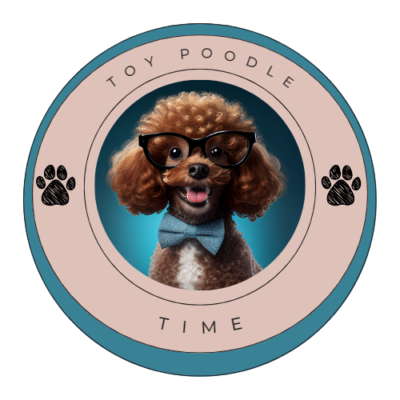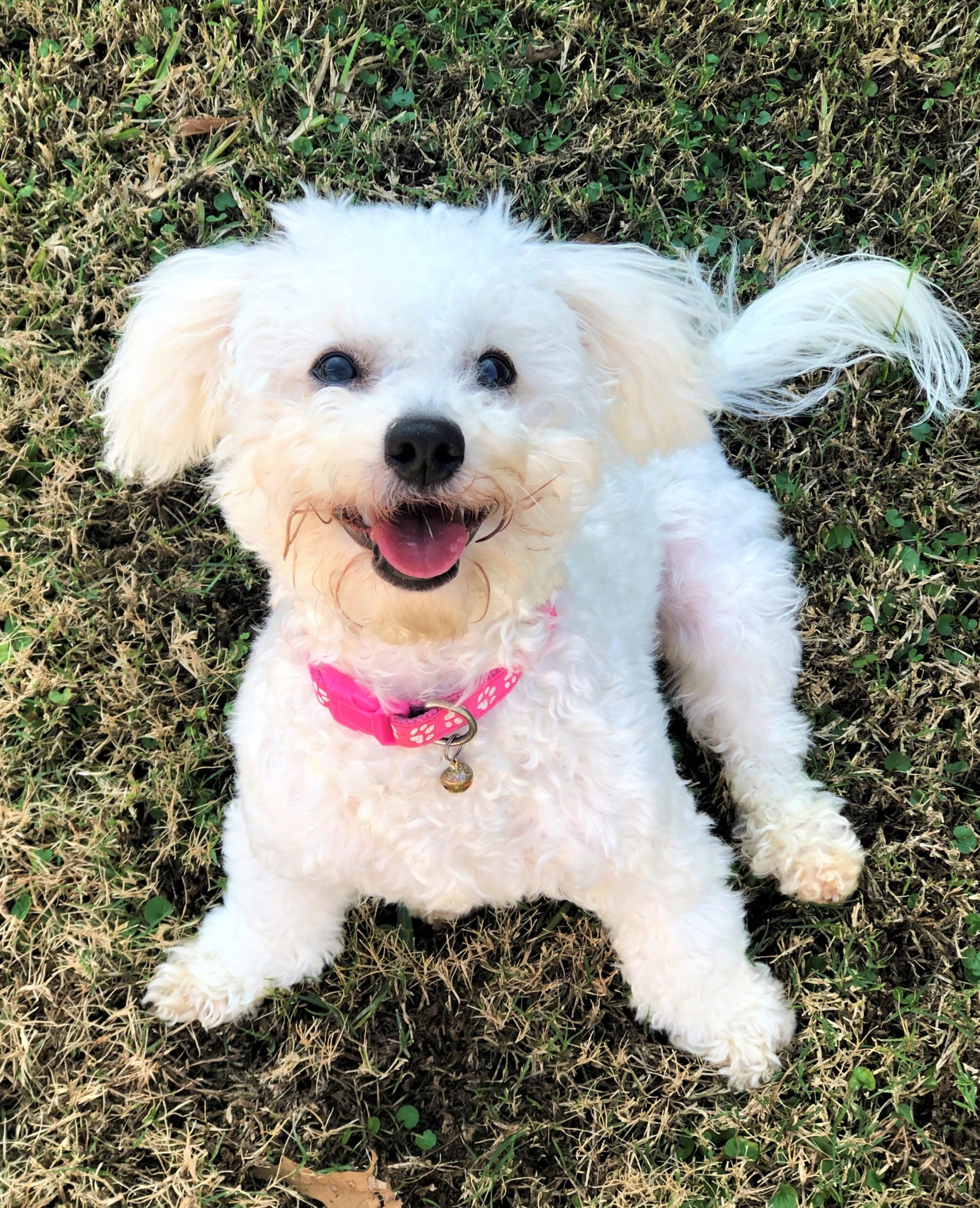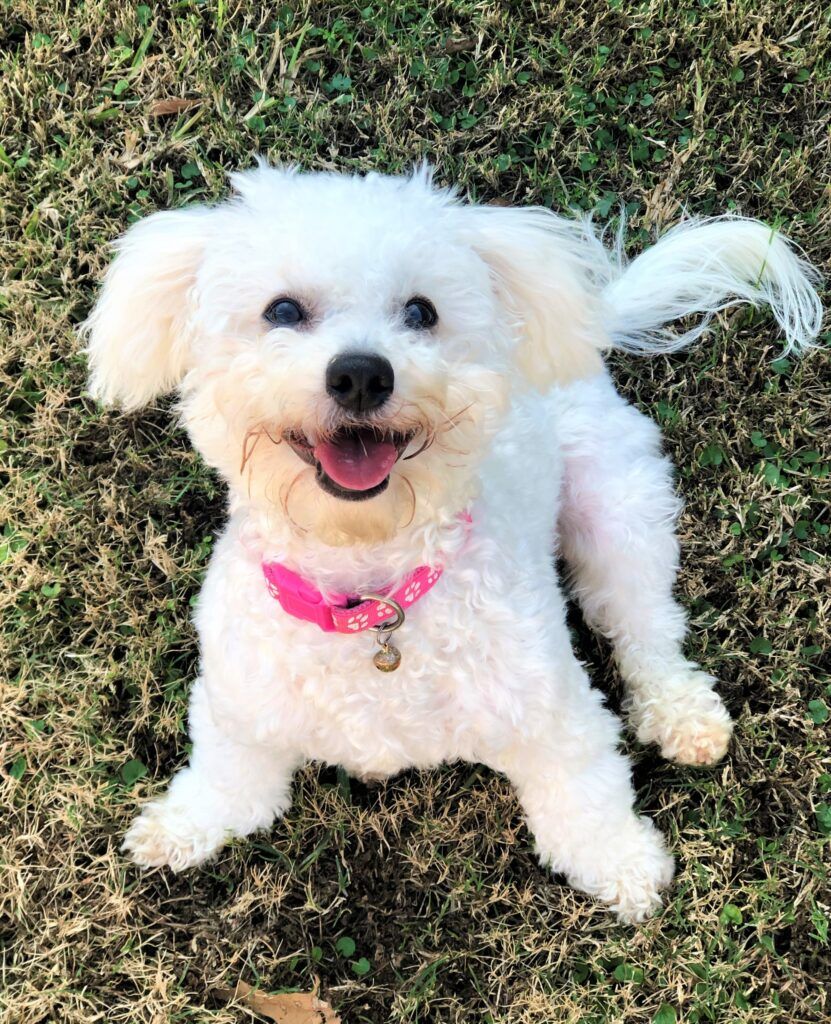
So, here’s a scenario I witnessed the other day. A young couple had just adopted a small dog. The dog has a collar and a leash on, and the couple put him down on the grass for one last pee before heading home in their car. The dog is so excited at his freedom that he starts the zoomies and promptly wiggles right out of his collar. Luckily for all of them, the adoption center sits on a quiet road, back from the highway. Also lucky for them is their new pet is highly food motivated and he’s coaxed back with a left-over egg McMuffin. What was a pretty comical scene, the couple running around trying to grab their new family member and him acting like “this is such a cool game of tag!”, could have potentially ended badly. Which is why I want to talk about dog collars for small dogs. What types of dog collars for small dogs are there? What is the best collar for your Toy Poodle? How do you choose the correct collar size? Let’s get down to business.
 What is a Dog Collar and Why You Need One
What is a Dog Collar and Why You Need One
A dog collar goes around your pet’s neck and is designed to attach to a leash. This combination of collar and leash allows you to have more control over your dog’s movements and to keep them safe. A dog collar can also carry your pup’s identification and rabies tags. In the event of an emergency (your pet runs away, gets lost, weather disaster, etc.) the likelihood of your pet being returned safely is greatly increased if they can be easily identified. A collar should not be a substitute for microchipping but used in addition to microchipping your pet. Think about it, if your dog was to get loose, they can be identified much faster by collar ID tags than by microchip (pretty sure most people don’t own a microchip reader).
 Your Poodle’s Activity Level
Your Poodle’s Activity Level
It is important to first off know what kind of activities your Toy Poodle will be doing to pick a proper collar. Is he a slow moving, gotta sniff every piece of grass Poodle like my Finny? Or a I got a lot of ground to cover on this walk mom, so let’s GO! type like my Sparky? Is your Poodle a never met a body of water I didn’t need to be in type? Do you do a lot of early morning or late-night walking? Keep your Poodle’s energy level and kind of activity in mind when deciding on which collar is right for them. You may decide that a collar is not the right choice, that maybe a small dog harness is a better option. Whatever you choose, the goal is to keep your Toy Poodle happy, safe, and secure.
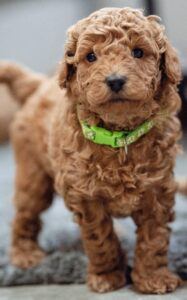 Choose a Well-Built Collar
Choose a Well-Built Collar
No matter what kind of collar you choose, make sure the collar is well-built with materials that are lightweight yet durable with strong rust resistant hardware. Check your pet’s collar frequently for wear and tear. Some collar materials begin to fray over time. Clip type hardware is super convenient but tends to crack with frequent use and in colder climates. A compromised collar can cause irritation and injury to your dog’s skin or break allowing your dog to run off.
There are lots of different types of dog collars. For simplicity’s sake, we are discussing collars for small dogs like your Toy Poodle, not collars for larger dogs. So, we’re going to leave out larger heavier collars, like the bulky chain ones, from this discussion. There are also several different types of training collars as well. That is a discussion best had between you and your trainer or vet when picking the best training collar for your Poodle.
Types of Dog Collars for Small Dogs
Standard (Flat) Collar
This classic design has a single buckle or clip with a metal ring for hooking a leash onto. This collar is a popular choice for many reasons. It is easy to use, inexpensive, lightweight, comfortable and comes in a variety of colors and patterns. The traditional standard collar is the most popular because it is suitable for most dogs in most situations. The standard collar works best for Poodles that don’t pull while walking on a leash or for outings to the doggie park. There are several different materials used to make the flat collar. Let’s look at the most popular:
 Nylon/Polyester Collar
Nylon/Polyester Collar
The nylon and polyester versions are probably what you think of first when talking about collars. They are lightweight, tough, durable, and generally inexpensive. Nylon and polyester collars can get rather nasty smelling if your Toy Poodle is more active, tends to treat walks as the perfect opportunity to roll around on the smelliest thing he can find, or loves playing in the water. Even though they are washable, it gets harder to remove that wet doggy smell over time. Nylon and polyester collars can be a bit stiff and may be a little too abrasive for your Toy Poodle’s skin, so check your pet’s neck regularly for irritation.
Glow in the Dark Collar
An excellent choice if you and your Poodle do a lot of early morning or late-night walking! Your tiny Toy needs all the help they can get being seen in low visibility situations. These collars are made with a reflective material that reflects the light being shined on it. Another option is a rechargeable LED lighted collar. They are easy to use and help to keep your pet safe. Some are even bright enough to help you see what you’re doing after your dog’s done pooing! Trust me, this is a helpful perk. If you can’t find a lightweight LED collar, a LED dog necklace worn along with your pup’s regular collar will also work.
Waterproof Collar
If your Poodle loves the water, you may want to choose a waterproof standard collar. These collars are usually made with waterproof coating material over nylon or polyester and rustproof coated metal hardware. The coating is also odor resistant and easy to clean. Waterproof collars are easy to wipe dry, so they won’t harbor smelly bacteria like a wet nylon collar. Some waterproof collars tend to be stiffer because of the coating material, so check your pup’s neck regularly for any irritation.
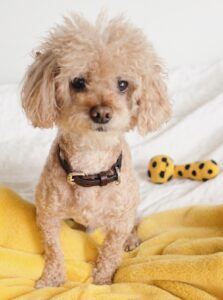 Leather Collar
Leather Collar
If you want to jazz up your Poodle’s wardrobe a little, you can opt for a leather collar. Natural leather collars are waterproof and softer on your Poodle’s skin. Poodles with a fancier cut may benefit from a leather collar since the leather tends to cause less damage to their hair. Leather collars may cost a little more but with proper care can last for years.
Breakaway Collar
The breakaway collar looks like the standard collar except that there is a safety release buckle built into the collar. When a leash is attached, the safety release mechanism will not work, but when worn alone, the safety release is designed to open when pressure is applied to the collar. The collar provides protection against collar related accidents such as strangulation. Leaving a collar on an unsupervised pet is a touchy subject, but if your Toy Poodle is left unsupervised for any amount of time with a collar on, it should be a breakaway type of collar.
Martingale Collar
These collars are primarily used for dogs with larger necks and smaller heads that standard collars may slip off easier. At first glance, the Martingale looks like the standard collar, but a portion of the collar runs between two metal rings. When the collar is pulled, these two rings are pulled closer creating a snug fit. The Martingale collar typically slips over your pup’s head and fits loosely around his neck while walking appropriately but tightens as your dog begins pulling. The design of this collar makes it nearly impossible for your dog to break free, even for the best Houdini. These collars are also typically made of nylon or polyester and chain and come in a variety of colors and patterns. The chain portion can sometimes pull your Poodle’s hair, so you may want to clip their neck hair shorter or opt for an all nylon one. Martingale collars also come with a buckle or clip design that allows you to place the collar without having to slip you’re your dog’s head. While primarily a training collar, many owners use the martingale for everyday walking because of the added control and protection from escape the collar provides. Please note, the Martingale collar is recommended for walking ONLY and should be removed when your pet is left unsupervised.
Head collar
This collar looks a lot like a horse halter, a portion of the collar fits around the muzzle, while a second attached portion sits high up on the dog’s neck. The purpose of the head collar is to give the walker more control, especially with leash pullers. There is some controversy with head collars, and since I’ve never used one with my Poodles, I am merely presenting it as a collar option and your vet or trainer may be able to provide more guidance.
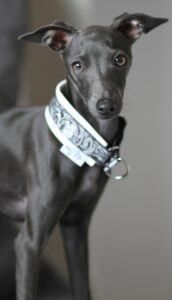 Wide vs Narrow Dog Collars
Wide vs Narrow Dog Collars
Collars come in a variety of widths. The width selection really depends on how comfortable your Poodle is in the collar. Since Toy Poodles are quite small, a thinner collar may be more comfy and lighter than a wider option. Keep in mind, the wider the collar, the larger the distribution of pressure on the neck. This means greater protection from neck damage, spinal injuries, eye injury, and long-term tracheal damage if your pup is a leash puller. In general, a ½ inch to ¾ inch wide collar is appropriate for your Toy Poodle.
A Word of Caution….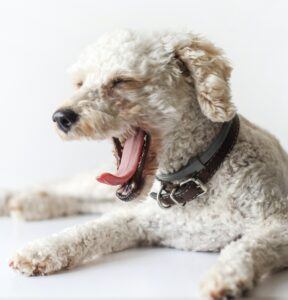
I can’t stress this point enough, so I’m going to go over some material again. Collars are recommended for small dogs that can walk loose leash properly. Leash pullers, particularly small dogs with respiratory issues, should not use collars for walks. Toy Poodles especially. Toy Poodles have very delicate tracheas and a collar putting pressure on that area can cause tracheal collapse. Small dogs that are leash pullers also run the risk of long-term complications such as neck damage, spinal injuries, and eye injury. If your small dog is a leash puller, you might want to choose a small dog harness instead.
Sizing for Dog Collars
So, how do you know you’ve chosen the correct collar size? Standard and breakaway collars should fit snugly on your Poodle’s neck. You’ll want it to sit on the higher part of his neck, not low near his shoulders. If the collar looks like it is resting on his shoulders, adjust the fit a little more snugly. However, you don’t want the collar too tight that it causes your pup discomfort, skin irritation, or makes it hard to breathe. A good rule of thumb – you should be able to get two fingers between your pet’s collar and his neck. Poodles can be quite fluffy so make sure you account for all the extra hair and have a close comfortable fit, so he doesn’t slip right out. A properly fitted collar also reduces the risk of injury to your pet. Your dog can easily get their loose-fitting collar caught on something that causes injury to their neck or break free and run into traffic. The key to getting a properly fitting collar is accurate measurement. Measure your dog’s neck with a flexible measuring tape or piece of string. Then do it again to make sure your measurements are accurate. You want the tape or string to sit snugly (not tightly) on your dog’s neck where the collar will sit. You now have an accurate measurement of your dog’s neck to compare against the company’s collar size chart. Martingale collar measuring is a little trickier. You’ll need two measurements when measuring for a martingale collar if it is the traditional type. Use the standard collar measurement and also measure the largest part of your dog’s head (usually jawline to the top of head). You will want to add 1” to this measurement so that the collar will slip over your dog’s head and ears. If possible, you should take your dog with you when buying a collar. This helps ensure you are getting the best collar choice for your furry friend.
Conclusion
There are so many great, high-quality collars for small dogs on the market today that finding the right one to fit your Toy Poodle’s lifestyle has never been easier. Ok, so now that you know about the types of dog collars for small dogs, now is the fun part, styling your Toy Poodle! With so many patterns, and colors available, you’d be hard-pressed not to find one that combines function and fashion to show off your Toy Poodle’s personality perfectly. What has been your experience with your Toy Poodle’s collar? Do you prefer one type over another? If you have any comments or questions, I’d love to hear from you.
